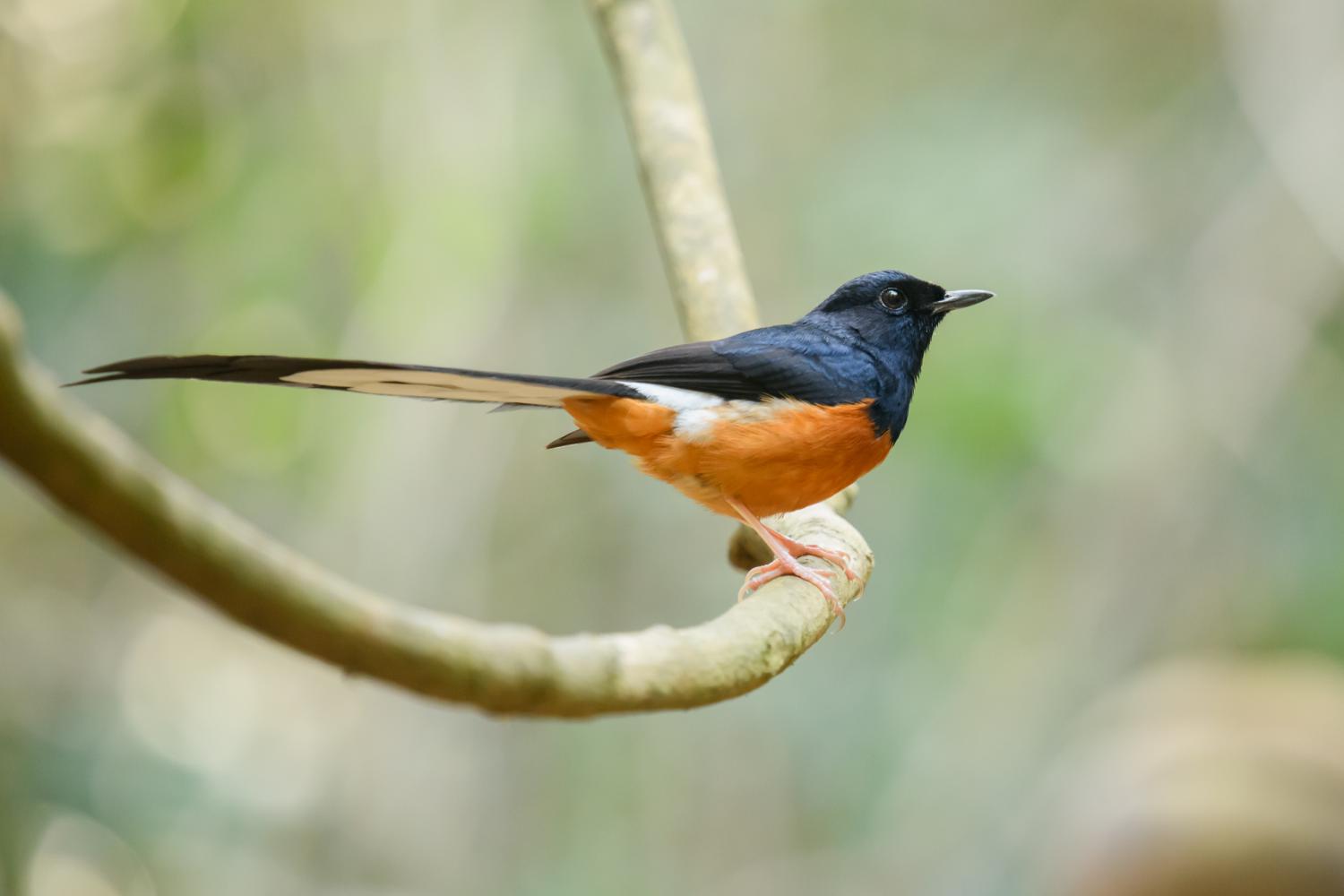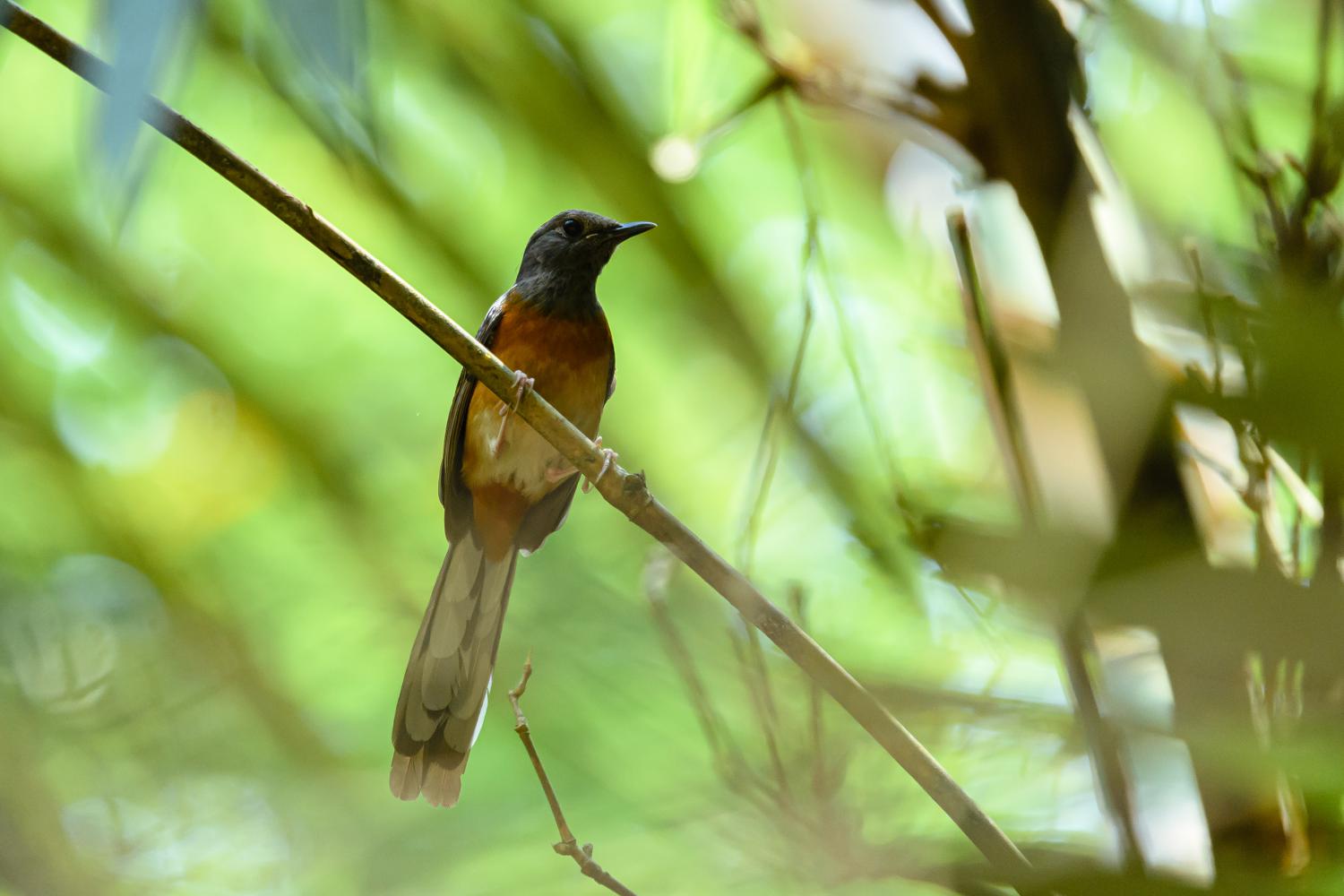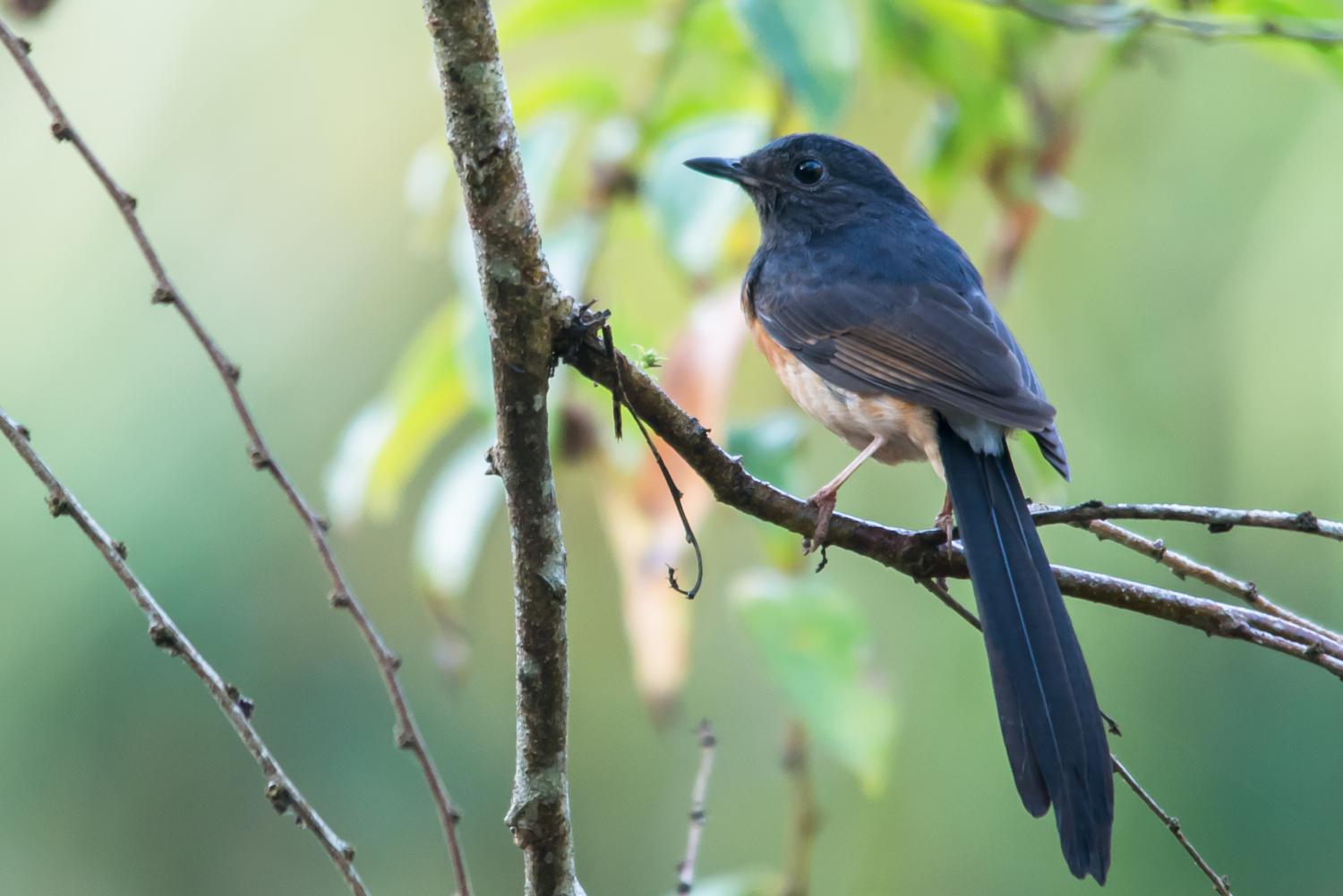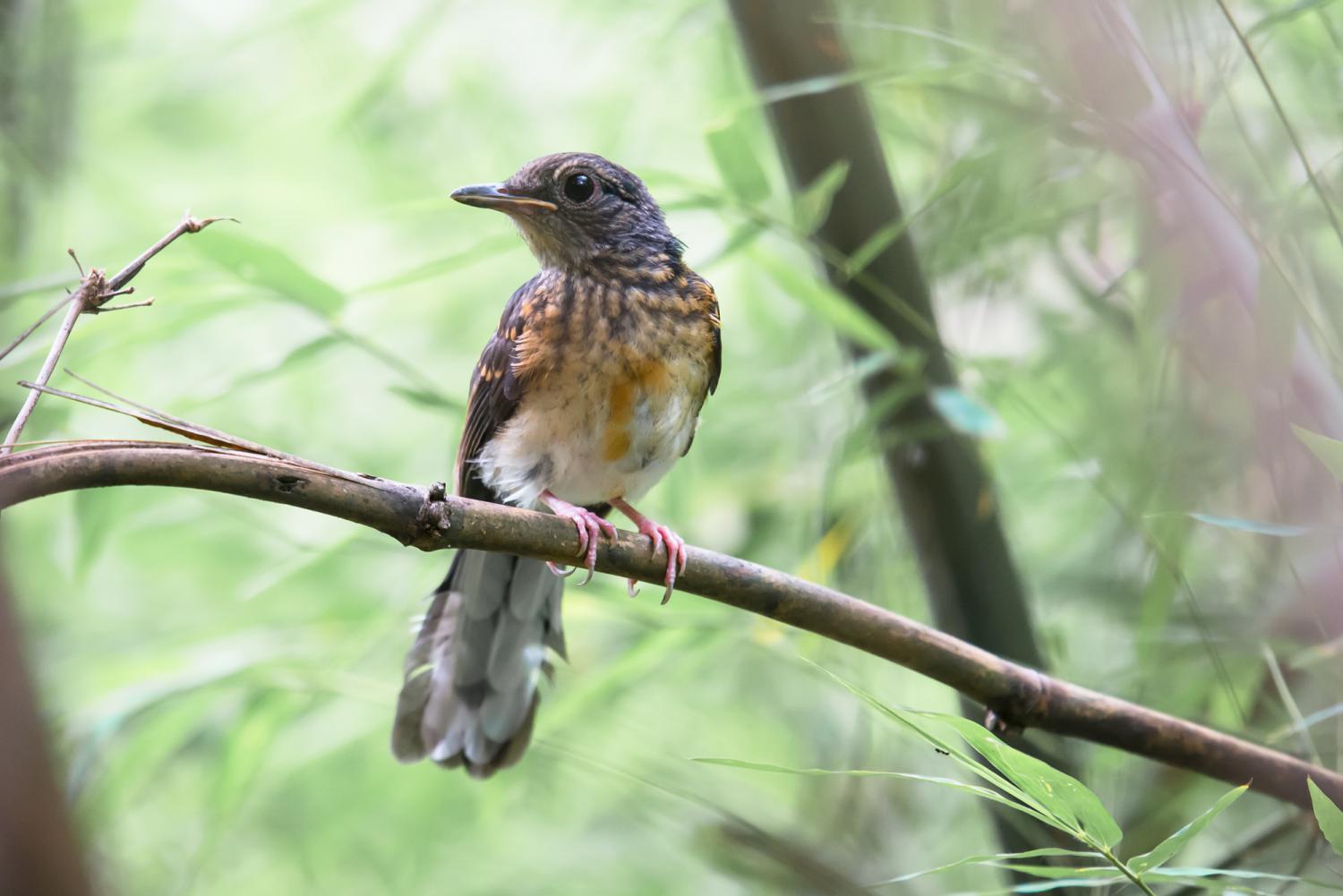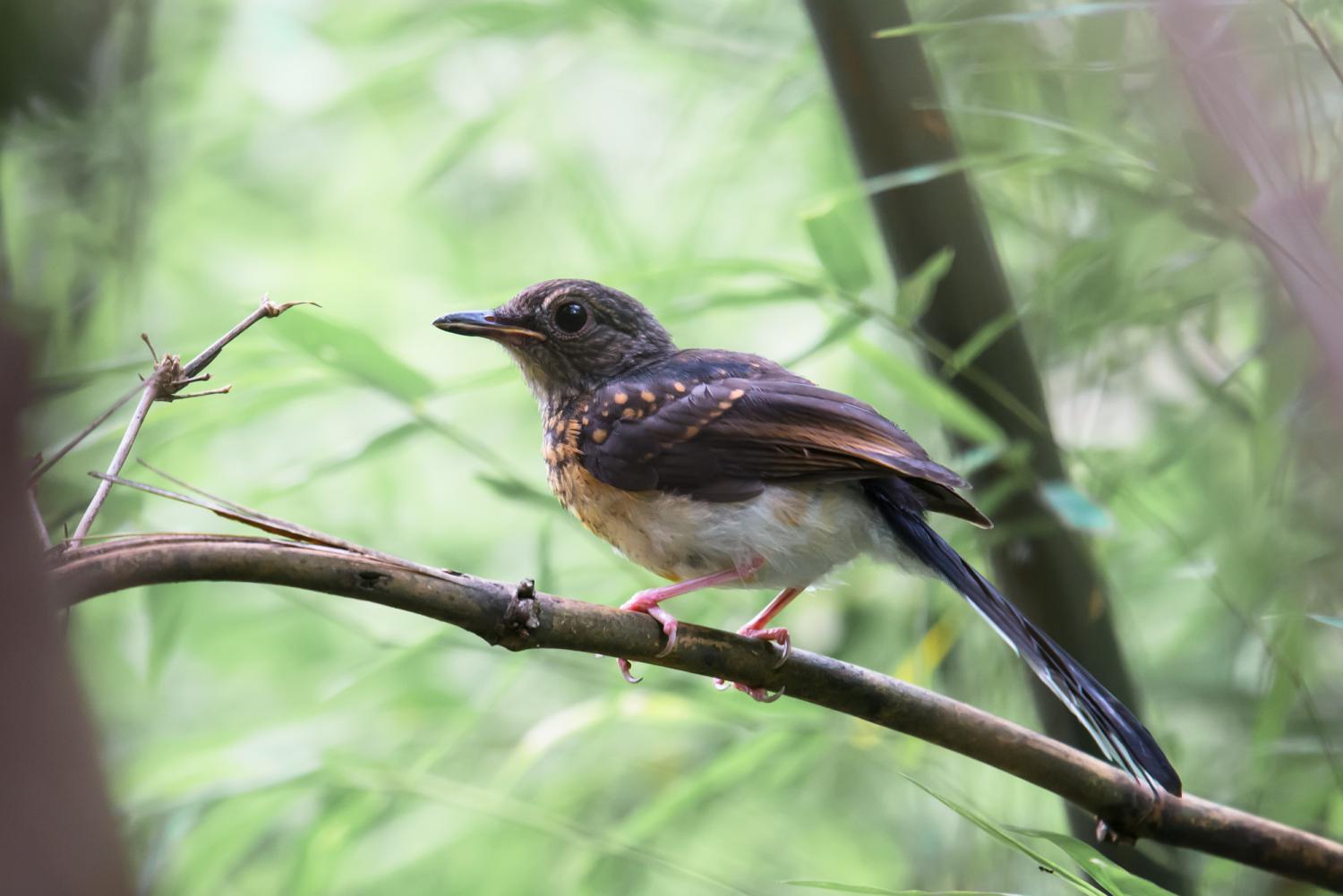Species of Thailand
White-rumped shama
Kittacincla malabarica
Giovanni Antonio Scopoli, 1788
In Thai: นกกางเขนดง
The white-rumped shama (Copsychus malabaricus) is a small passerine bird of the family Muscicapidae. Native to densely vegetated habitats in the Indian subcontinent and Southeast Asia, its popularity as a cage-bird and songster has led to it being introduced elsewhere.
Taxonomy
It was formerly classified as a member of the thrush family, Turdidae, causing it to be commonly known as the white-rumped shama thrush or simply shama thrush.
Subspecies
The nominate race is found in the Western Ghats and parts of southern India while leggei is found in Sri Lanka. Race indicus is found in the northern parts of India. Race albiventris is found in the Andaman Islands and now usually considered a distinct species, the Andaman shama. Race interpositus from southwestern Asia-China to Myanmar, Thailand and the Mergui Archipelago. Southern China has race minor while mallopercnus is found in the Malay peninsula. Race tricolor is found in the Sumatra, Java, Banka, Belitung and Karimata islands. Race mirabilis from the Sunda Strait, melanurus from northwestern Sumatra, opisthopelus, javanus, omissus, ochroptilus, abbotti, eumesus, suavis (Borneo), nigricauda, stricklandii and barbouri are the other island forms. The last two are sometimes regarded as a separate species, the white-crowned shama (C. stricklandii).
Description
They typically weigh between 28 and 34 g and are around 23 - 28 cm in length. Males are glossy black with a chestnut belly and white feathers on the rump and outer tail. Females are more greyish-brown, and are typically shorter than males. Both sexes have a black bill and pink feet. Juveniles have a greyish-brown colouration, similar to that of the females, with a blotchy or spotted chest.
Breeding
The white-rumped shama is shy and somewhat crepuscular but very territorial. The territories include a male and female during the breeding season with the males defending the territory averaging 0.09 ha in size, but each sex may have different territories when they are not breeding.
In South Asia, they breed from January to September but mainly in April to June laying a clutch of four or five eggs in a nest placed in the hollow of a tree. During courtship, males pursue the female, alight above the female, give a shrill call, and then flick and fan out their tail feathers. This is followed by a rising and falling flight pattern by both sexes. If the male is unsuccessful, the female will threaten the male, gesturing with the mouth open.
The nest is built by the female alone while the male stands guard. The nests are mainly made of roots, leaves, ferns, and stems, and incubation lasts between 12 and 15 days and the nestling period averaged 12.4 days. Both adults feed the young although only the female incubates and broods. The eggs are white to light aqua, with variable shades of brown blotching, with dimensions of about 18 and 23 mm.
Feeding
They feed on insects in the wild but in captivity they may be fed on a diet of boiled, dried legumes with egg yolk and raw meat.
Voice
The voice of this species is rich and melodious which makes them popular as cage birds in South Asia with the tradition continuing in parts of Southeast Asia. It is loud and clear, with a variety of phrases, and often mimics other birds. They also make a 'Tck' call in alarm or when foraging. One of the first recordings of a bird song that was ever made was of this species. This recording was made in 1889 from a captive individual using an Edison wax cylinder by Ludwig Koch in Germany.
Distribution and habitat
They are native across scrub and secondary forests in South and Southeast Asia, but have been introduced to Kauai, Hawaii, in early 1931 from Malaysia (by Alexander Isenberger), and to Oahu in 1940 (by the Hui Manu Society). Their popularity as a cage bird has led to many escaped birds establishing themselves. They have been introduced to Taiwan where they are considered an invasive species, eating native insect species and showing aggression towards native bird species.
In Asia, their habitat is dense undergrowth especially in bamboo forests. In Hawaii, they are common in valley forests or on the ridges of the southern Koolaus, and tend to nest in undergrowth or low trees of lowland broadleaf forests.
This article uses material from Wikipedia released under the Creative Commons Attribution-Share-Alike Licence 3.0. Eventual photos shown in this page may or may not be from Wikipedia, please see the license details for photos in photo by-lines.
Category / Seasonal Status
BCST Category: Recorded in an apparently wild state within the last 50 years
BCST Seasonal status: Resident or presumed resident
Scientific classification
- Kingdom
- Animalia
- Phylum
- Chordata
- Class
- Aves
- Order
- Passeriformes
- Family
- Muscicapidae
- Genus
- Kittacincla
- Species
- Kittacincla malabarica
Common names
- Thai: นกกางเขนดง
Synonyms
- Cittocincla macrura
- Kittacincla macrura
Conservation status

Least Concern (IUCN3.1)

Near Threatened (ONEP)
Photos
Please help us review the bird photos if wrong ones are used. We can be reached via our contact us page.
Range Map

- Ang Thong National Marine Park
- Ao Phang-Nga National Park
- Ban Bueng District, Chonburi
- Ban Pho District, Chachoengsao
- Bang Lamung District, Chonburi
- Bang Lang National Park
- Bang Phra Non-Hunting Area
- Bangkok Province
- Bueng Khong Long Non-Hunting Area
- Chae Son National Park
- Chaloem Phrakiat Thai Prachan National Park
- Chaloem Rattanakosin National Park
- Chiang Dao District, Chiang Mai
- Chiang Dao Wildlife Sanctuary
- Chiang Khong District, Chiang Rai
- Chiang Saen District, Chiang Rai
- Dan Sai District, Loei
- Doi Chong National Park
- Doi Inthanon National Park
- Doi Lang
- Doi Lo District, Chiang Mai
- Doi Pha Hom Pok National Park
- Doi Phu Kha National Park
- Doi Saket District, Chiang Mai
- Doi Suthep - Pui National Park
- Erawan National Park
- Hala-Bala Wildlife Sanctuary
- Hang Chat District, Lampang
- Hat Wanakon National Park
- Huai Kha Khaeng Wildlife Sanctuary
- Huai Yang Waterfall National Park
- Kaeng Khoi District, Saraburi
- Kaeng Krachan District, Phetchaburi
- Kaeng Krachan National Park
- Kaeng Krung National Park
- Kaeng Som Maew Queen Sirikit Forest Park
- Kanthararom District, Sisaket
- Kantharawichai District, Maha Sarakham
- Khao Ang Rue Nai Wildlife Sanctuary
- Khao Banthat Wildlife Sanctuary
- Khao Chamao - Khao Wong National Park
- Khao Khiao - Khao Chomphu Wildlife Sanctuary
- Khao Khitchakut National Park
- Khao Laem National Park
- Khao Laem Ya - Mu Ko Samet National Park
- Khao Luang National Park
- Khao Nam Khang National Park
- Khao Nan National Park
- Khao Nang Phanthurat Forest Park
- Khao Phra - Bang Khram Wildlife Sanctuary
- Khao Phra Thaeo Wildlife Sanctuary
- Khao Pu - Khao Ya National Park
- Khao Sam Roi Yot National Park
- Khao Sanam Prieng Wildlife Sanctuary
- Khao Soi Dao Wildlife Sanctuary
- Khao Sok National Park
- Khao Yai National Park
- Khlong Kaeo Waterfall National Park
- Khlong Lan National Park
- Khlong Luang District, Pathum Thani
- Khlong Saeng Wildlife Sanctuary
- Khon San District, Chaiyaphum
- Khun Chae National Park
- Khun Korn Forest Park
- Khun Tan District, Chiang Rai
- Khung Kraben Non-Hunting Area
- Khura Buri District, Phang Nga
- Ko Chang National Park
- Ko Lanta National Park
- Ko Phayam
- Kromluang Chumphon Wildlife Sanctuary
- Kui Buri National Park
- Lam Nam Kok National Park
- Lan Sang National Park
- Mae Ai District, Chiang Mai
- Mae Charim National Park
- Mae Fa Luang District, Chiang Rai
- Mae Moei National Park
- Mae Ping National Park
- Mae Rim District, Chiang Mai
- Mae Sai District, Chiang Rai
- Mae Sot District, Tak
- Mae Taeng District, Chiang Mai
- Mae Wong National Park
- Muak Lek District, Saraburi
- Mueang Chiang Mai District, Chiang Mai
- Mueang Chiang Rai District, Chiang Rai
- Mueang Chumphon District, Chumphon
- Mueang Kanchanaburi District, Kanchanaburi
- Mueang Khon Kaen District, Khon Kaen
- Mueang Krabi District, Krabi
- Mueang Lampang District, Lampang
- Mueang Loei District, Loei
- Mueang Maha Sarakham District, Maha Sarakham
- Mueang Nakhon Nayok District, Nakhon Nayok
- Mueang Nan District, Nan
- Mueang Sa Kaeo District, Sa Kaeo
- Mueang Tak District, Tak
- Nam Nao National Park
- Nam Phong National Park
- Namtok Sam Lan National Park
- Nong Bong Khai Non-Hunting Area
- Nong Ya Plong District, Phetchaburi
- Omkoi Wildlife Sanctuary
- Op Khan National Park
- Pa Sang District, Lamphun
- Pachee River Wildlife Sanctuary
- Pai District, Mae Hong Son
- Pang Sida National Park
- Pha Daeng National Park
- Phan District, Chiang Rai
- Phato District, Chumphon
- Phatthana Nikhom District, Lopburi
- Phra Nakhon Si Ayutthaya District, Phra Nakhon Si Ayutthaya
- Phu Chong Na Yoi National Park
- Phu Foi Lom National Park
- Phu Hin Rong Kla National Park
- Phu Khiao Wildlife Sanctuary
- Phu Kradueng National Park
- Phu Luang Wildlife Sanctuary
- Phu Phan National Park
- Phu Suan Sai National Park
- Phu Toei National Park
- Phu Wiang National Park
- Ramkhamhaeng National Park
- Sadeth Naikrom - Krom Luang Wildlife Sanctuary
- Sai Yok District, Kanchanaburi
- Sai Yok National Park
- Sakaerat Environmental Research Station
- Salak Pra Wildlife Sanctuary
- Salawin National Park
- Samae San Island
- San Kala Khiri National Park
- San Sai District, Chiang Mai
- Sanam Chai Khet District, Chachoengsao
- Sangkhom District, Nong Khai
- Sattahip District, Chonburi
- Si Racha District, Chonburi
- Sirinat National Park
- Sri Nakarin Dam National Park
- Sri Phang-nga National Park
- Surin Islands
- Ta Phraya National Park
- Tai Rom Yen National Park
- Taksin Maharat National Park
- Takua Pa District, Phang Nga
- Tat Mok National Park
- Tat Ton National Park
- Tha Yang District, Phetchaburi
- Thale Ban National Park
- Tham Pla - Namtok Pha Suea National Park
- Tham Pratun Non-Hunting Area
- Thap Lan National Park
- Thong Pha Phum National Park
- Thung Salaeng Luang National Park
- Thung Yai Naresuan Wildlife Sanctuary
- Ton Nga-Chang Wildlife Sanctuary
- Wang Mai Forest Restoration Project
- Wang Saphung District, Loei
- Wat Phai Lom & Wat Ampu Wararam Non-Hunting Area
- Wat Tham Erawan Non-Hunting Area
- Wiang Kaen District, Chiang Rai
- Wiang Lo Wildlife Sanctuary
